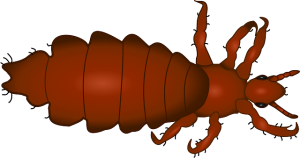
Hello! Finally, I had a more or less free day lately. Thought to relax and rest.
Yeah. Petrovna came running from across the street and sounded the alarm. Her seven-year-old granddaughter has been staying for the second week. I started complaining a couple of days ago that my head was very itchy.
We looked carefully - and she got lice! Urgently taken measures to eliminate them so that the child does not suffer. Want to find out where lice come from in a person from the beginning and how to get rid of them quickly? Then now I will tell you everything in detail.
The content of the article:
Where do lice come from in humans originally
Despite the huge variety of hygiene products used by modern man, they still can not 100% protect him from surrounding parasites.
But where does lice come from in humans initially? There are quite a few wild misconceptions that can be heard even from educated people, so today we will conduct a small “educational program for lice” and consider the main causes of pediculosis.
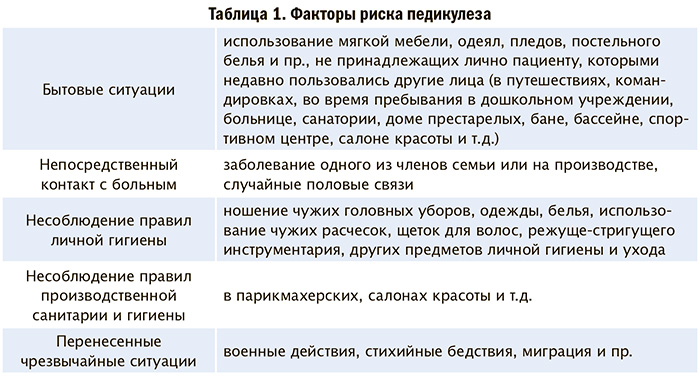
The main reasons for the appearance
The problem under consideration is very relevant, because these parasites, as a rule, appear suddenly. In fact, despite numerous myths, it is necessary to clarify the main thing - lice are external parasites, and only a person can be their carrier.
Lice feed on human blood, while the "owner" is constantly suffering from discomfort, manifested in the form of itching and pain in the affected areas.
By the way, lice can be of several types:
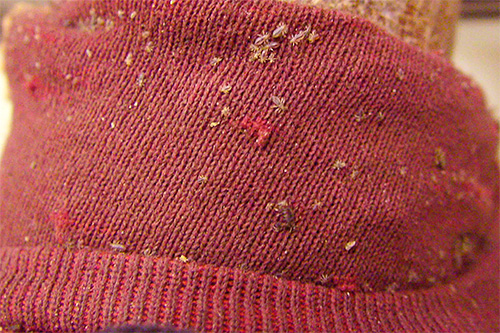
All these parasites are transmitted by contact, and this can be not only direct interaction with the wearer, but also the use of his personal belongings (razors, combs, etc.). Lice cannot be transmitted through food or animals.
Where do lice come from:
- Public places. These are potential risk areas. A striking example is, say, children's institutions. Children are often infected with pediculosis in kindergartens and schools.
- Water. Yes, water can indeed act as a source of infection, since lice can live in it for some time. That is why it is quite possible to catch parasites in a body of water with stagnant water, not only in the pool, but also in a rural lake.
- Close contacts.As noted above, lice can be transmitted through human interactions. This can be, for example, kisses or sexual intercourse (more related to pubic parasites), group games (mainly childhood infections).
- Neglect of hygiene rules. Parasites are often wound up in those who neglect personal hygiene, live in unsanitary conditions.
- Long drive. The risk of infection in such cases increases. And the point here is not only that there is by no means always access to the simplest hygienic procedures, but also that you have to come in contact with a large number of people on the road, including with pediculosis carriers.
- Cohabitation of people. This applies to places where a large number of people live (summer camps, prisons, etc.).
- Personal items of the carrier. Towels, combs and other things of the carrier of the disease containing lice or nits can also be contagious. Few people know that these parasites can live without air for up to 24 hours.
According to statistics, lice are most often infected in autumn and winter, when people spend most of the time indoors, actively contacting each other.
Sources of infection
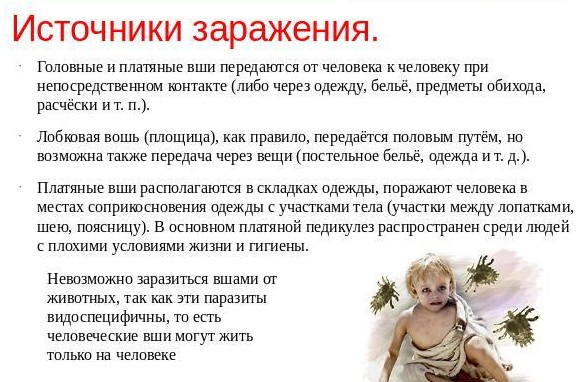
But, in principle, pediculosis can occur under different circumstances. So, just standing next to the carrier in public transport is enough for the parasites to crawl onto the hair of another person.
Yes, lice can’t jump like fleas, but they crawl quickly (about 4 mm / sec.), And when they get to the new “master”, they begin to bite it actively and multiply. The incubation period of lice, by the way, takes about three weeks. When infection with head lice, the incubation period of lice is 2-4 weeks
Misconceptions about pediculosis infection
There are several myths that need to be debunked. Let's start with the most popular.
Misconception number 1. Mud. We can safely say that these parasites appear mainly on the head. And people who observe all standards of hygiene are very surprised to find pediculosis in themselves.
Misconception number 2. Stressful situations. Can lice develop under stress? Many are sure of this, explaining everything by the fact that on the skin of each person there are lice and nits that are in a state of hibernation and waiting for the right moment.
Like, the irregularities on the head are nothing more than clusters of bloodsuckers. And when a person is aroused, blood flow to the head increases, which leads to the activation of parasites. Those begin to move, eat and, of course, actively multiply.
Pediculosis cannot develop as a result of stress; this statement has no evidence whatsoever. Moreover, in the scientific world it is not even considered due to absurdity and illogicality.
Misconception number 3. Spoilage. This hypothesis has no right to exist at all, but it still has a lot of fans who believe that pediculosis is supposedly the result of the influence of negative energy.
In other words, a person may have lice due to a evil eye, and they themselves are harbingers of something bad.
It is also worth noting that when considering all sorts of opinions a la “people say”, critical thinking needs to be connected. Suppose parasites really “sleep” on your head, but then the question arises: how did they get there at all? In addition, pediculosis is not a hereditary disease, let some be sure of the opposite.
It is scientifically proven that under the skin of newborn babies there are no parasites. It has also been proven that without human blood, lice die in 48 hours.That is why the hypothesis of "hibernation" can be confidently called absurd.
How not to confuse with other dermatological diseases?
The signs of lice are very similar to the symptoms of some skin diseases.
- Dermatitis. This ailment occurs against the background of nervous stress, and if a person has additionally been in contact with the carrier of pediculosis, but a very confusing, it would seem, picture. But in reality, both problems are in no way connected with each other.
- Scabies. It is confused with the appearance of lice most often. Nevertheless, scabies is caused by a completely different parasite - a subcutaneous tick, and the disease itself differs from pediculosis by the absence of nits in the hair and visible bite marks.
- Psoriasis. A symptom of psoriasis (an incurable disease), as well as pediculosis, is a strong undulating itch. Quite often, people believe that they have become infected with lice, up to the diagnosis.
How to identify lice?
Symptoms of lice may occur after a certain time (up to 20 days) after infection. This is enough for the parasites to breed.
The characteristic symptoms of the disease include:
- severe itching in places of bites;
- skin irritation, scratching;
- white lumps (nits) near the roots of the hair;
- untidiness of hair, less often - inflammation of the hair follicles.
In addition, with careful study, you can notice in the hair and the parasites themselves.
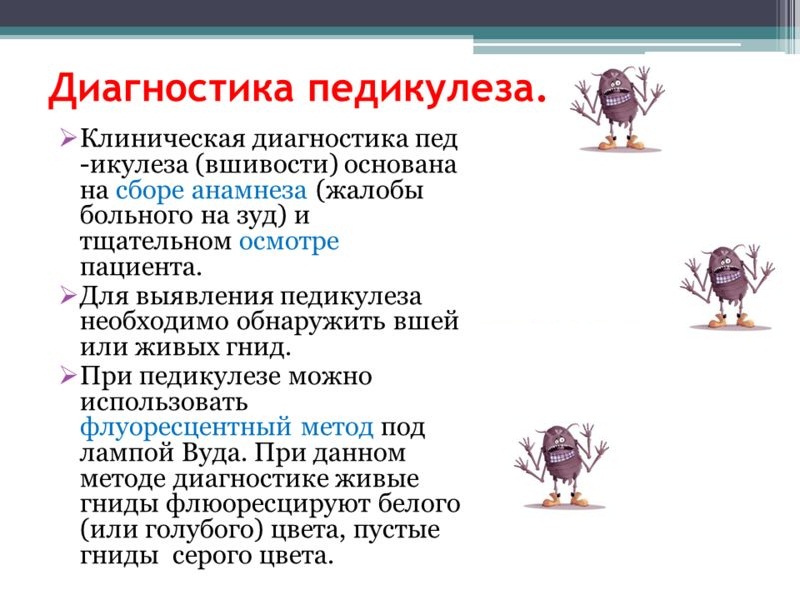
If you do not take any measures, then the disease will start and other symptoms will appear, such as:
- tangles (hair that stuck together or clumped) on the head;
- sleep disturbance;
- boils, dermatitis;
- irritability;
- enlarged lymph nodes behind the auricles.
And if a person has all the symptoms of an early infection, then it is safe to say that he has lice. In this case, treatment should be started immediately.
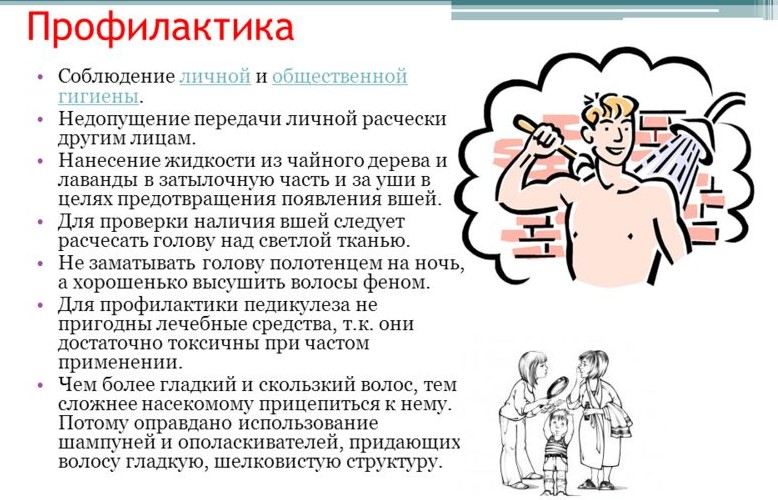
In the end, we note that the sooner the disease is diagnosed, the better for the patient. This statement is especially relevant in relation to pediculosis. A person who has got parasites doesn't care what the reason for their appearance is, the main thing is to get rid of the problem.
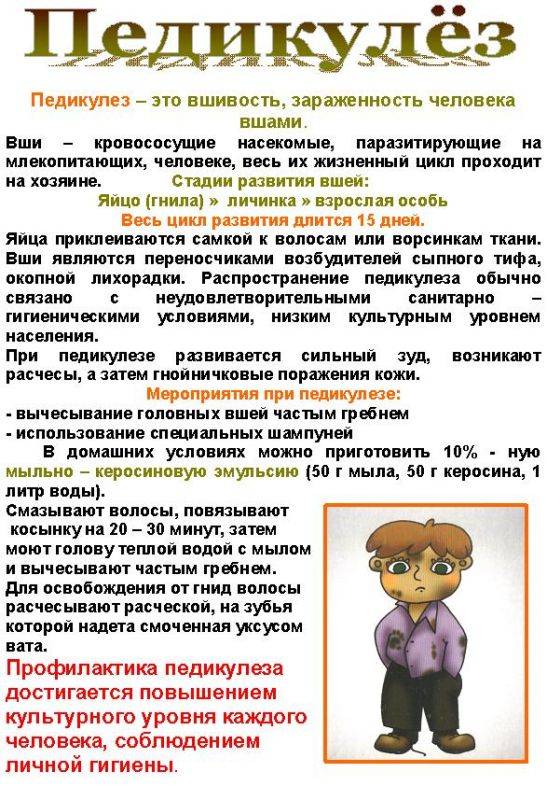
What causes lice on the head of a child and adults
Despite the huge amount of all kinds of personal hygiene products that a modern person uses, he does not manage to 100% get rid of the surrounding parasites. For example, lice suddenly appear on your head from nowhere.
The subheading question is more than logical, since these insects appear, as a rule, very unexpectedly. In fact, despite a lot of speculation on this topic, you must first learn that lice are external parasites.
Moreover, only a person can be a carrier of this infection. The parasite feeds on human blood, while the "host" constantly feels discomfort in the form of pain and itching in the habitats of lice.
Pediculosis is transmitted by contact. This can be a direct interaction with a person or the use of his personal things - a comb, hairpin, towel, razor. Studying further the problem of what lice come from, the following circumstances should be highlighted:
The source of infection may be water. The fact is that lice can live in water for some time. And this means that in a standing reservoir, this infection can actually be picked up. This applies equally to the rural lake and the urban basin. By the way, this paragraph partially answers the question of where the lice come from in the child.
High crowded areas are potential risk areas. As an example, the easiest way to cite children's institutions. Often, stories of where lice originally come from begin with the phrases “I brought my daughters from school” or “a small child got infected in kindergarten”.
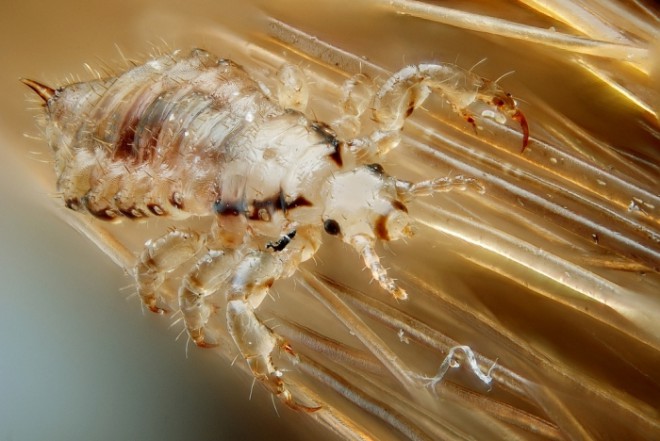
Types of Lice:
- Headache.
- Pubic.
- Wardrobe.
Where do lice come from: debunking myths
Myth # 1 Dirt. Today, we can clearly state that most often this bloodsucker appears on the head. And every time a person who respects all hygiene standards is shocked when pediculosis is detected.
It is more important to convey information that on clean hair, in the process of washing deprived of natural plaque from particles of dirt and dust, as well as greasy coating, parasites feel much better than in a dirty environment. It’s much easier for them to get to a power source - blood.
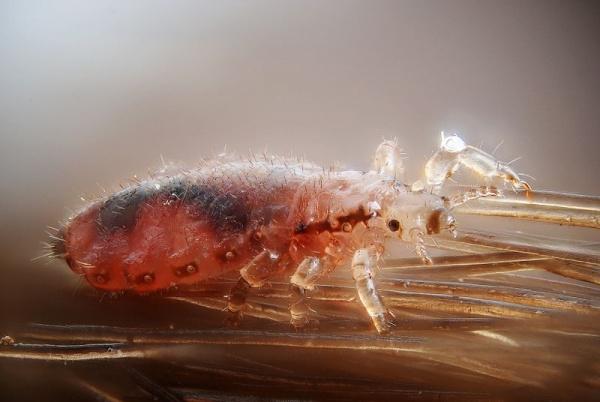
Myth # 2 Stress. Can stress lice appear? Very often you can hear an affirmative answer and a lengthy explanation that for every person in the scalp for the time being, both lice and their eggs, nits, are in a state of hibernation.
With nervous excitement, the blood flow to the head increases, and the parasites become more active. They crawl to the surface of the skin of the head and begin to multiply actively.
Lice from stress can not appear. This pseudo-theory never had any evidence. Moreover, the hypothesis of whether lice from stress may appear in the scientific world is not, in principle, considered. In view of its illogical and absurdity.
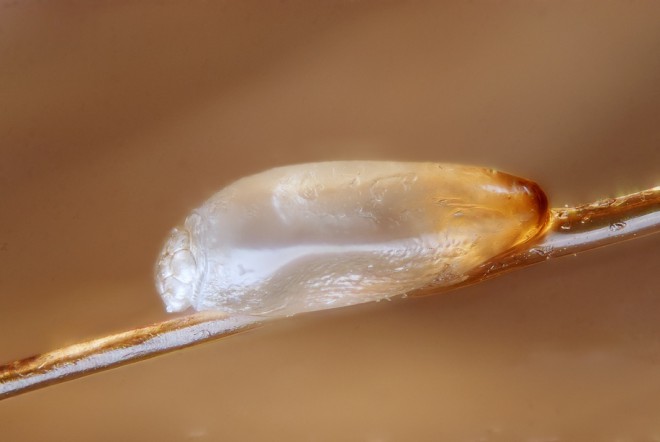
Myth # 3 Corruption. Another not having the right to exist, but strangely enough still having fans, the hypothesis that pediculosis is a consequence of the impact of negative energy.
So you can hear that lice appeared on a nervous basis in a child or adult due to a bad eye. Moreover, these parasites are the harbingers of something bad in life.
Considering the points of view from the category of "people say", we include critical thinking. Even if they’re “sleeping” in our heads for some time without revealing ourselves, the question arises of how they got there. Pediculosis is not a hereditary disease.
It is absolutely known that a newborn baby has no parasites under the skin. And it has also been scientifically proven that without feeding on human blood, the parasite dies after 2 days. Therefore, the "hibernation" of lice is nonsense.
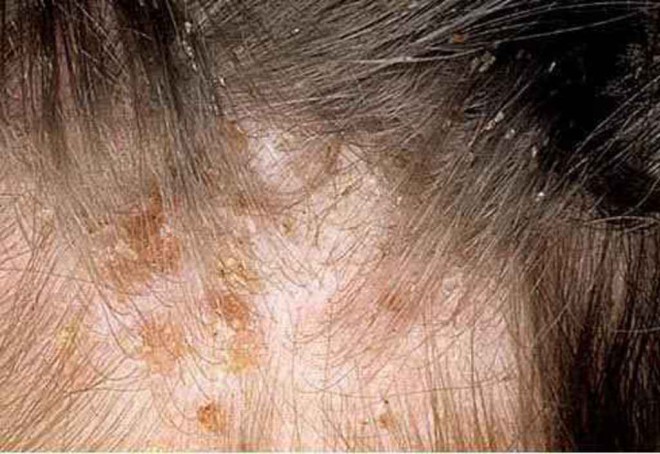
Be vigilant - do not be confused
Symptoms of lice infection are very similar to other skin diseases:
- Dermatitis. This disease very often accompanies nervous stress, and if at the same time there was contact with the lice carrier, then a very ambiguous picture appears at first glance. In fact, these two troubles are not interconnected.
- Psoriasis. The wave-like intensity of itching is one of the symptoms of this incurable disease, which also occurs with lice. There are cases that before the diagnosis of psoriasis, a person believes that he has lice.
- Scabies. This infection with pediculosis is most often confused. However, it occurs due to another parasite - a subcutaneous tick. The difference between scabies and pediculosis is the absence in the first case of clear traces of a bite and nits on the hair.
In conclusion, we want to recall that the sooner a disease is detected, the easier it is to treat it. In the case of lice, this is more than relevant. The person who has become infected with them no matter where they came from, the main thing is to know how to get rid.
Causes of Lice
Lice have been parasitic in humans for more than 80,000 years.This is the only type of obligate insects that do not leave the human body, but are constantly on it. Louse is a small blood-sucking insect, the sizes of which vary in the range of 0.6-6 mm.
The state of lice is called pediculosis and is considered a disease. Parasite infestations affect all segments of the population. Therefore, the question of where lice come from in a person’s head remains relevant for centuries.
Ectoparasites are characterized by rapid reproduction. The female lays eggs - nits, sticking them with sticky mass to her hair. Over its short life, about 38 days, it gives life to several hundred individuals. The full development cycle from egg to imago lasts no more than 20 days.
Nature did not reward the parasite with jumping and flying skills. He can only crawl and moves at a speed of 10-20 cm per minute. However, such limited motor capabilities do not prevent distribution among people. There are several reasons why lice appear on the head.
Contact with an infected person. Being at close range with the carrier of the parasite, the louse can easily crawl to a new object. The process of pediculosis infection occurs in public transport, in places of mass crowding.
According to Rospotrebnadzor, a sharp increase in lice was recorded among adolescents. Every day, the younger generation sticks to each other to take a picture on a mobile phone, thereby increasing the risk of spread of lice.
Things and care products. Sharing of combs, wearing hats, scarves with an infected person is one of the most common reasons where lice come from on the head.
In the first days of infection, a person still does not feel signs of the presence of foreign bodies, but this does not prevent adults from traveling, using objects in contact with the hairline as a vehicle.
Girls lending combs and hairpins is one of the most likely versions of where children get lice on their heads. It is difficult for young fashionistas to refuse friends and not to borrow their personal belongings from them.
Pools, standing reservoirs, baths. It has been proven that lice remain viable while in water for several days. Therefore, bathing in baths, baths without changing the water, in a pool or a standing pond without a rubber cap often cause pediculosis.
High crowded places. After visiting preschool, school, summer, health camps in which pediculosis is common, there are lice in the child. Children become infected during games, recreation, sleep.
In social facilities, a regular scheduled inspection is carried out for lice, but given the short incubation period and the large audience, these measures are not enough. For the same reason, lice appear in an adult. Sanatoria, prisons, hotels, hostels are the sources of the spread of head lice.
The most ridiculous assumptions about the occurrence of pediculosis
Although insects have been living side by side with humans for many centuries, it is not known for certain where lice originally come from. Like all parasites, they spread from one object to another.
Bursts of pediculosis growth can occur during natural disasters, military operations, and population migration.
Unlike fleas, lice are loyal to their carrier and are not able to move from animals to humans and vice versa. Therefore, the presence of pets in the house has nothing to do with the lice of their owner.
The most common misconceptions that make lice appear:
Non-compliance with hygiene. Regular shampooing is not related to pediculosis infection. Lice and nits are wound both in clean people and those who neglect water procedures.
Parasites need blood, not dirt. In clean hair, without the presence of sebaceous components, they feel even better, since nothing interferes with their movement.
Lice live under the scalp and wait for the right moment. Such a statement does not hold water. Pediculosis is not a hereditary disease and no parasites under the scalp have been detected in newborn babies.
Spoilage. Although this version has its fans who are sure that lice are the result of negative energy, but sensibly people think this is completely absurd.
Signs of head lice
The incubation period lasts 20-21 days. In the early days, until the parasites massively bred, their presence may go unnoticed. When their number increases, the following symptoms appear:
- severe itching;
- the appearance of small wounds on the skin;
- inflammatory process in the hair follicles;
- clumping of hair, the appearance of white lumps;
- irritability;
- sleep disturbances;
- the appearance of abscesses, boils;
- the presence of adults and nits in the hairline.
Pediculosis needs treatment. For this, special shampoos are used, which are sold in pharmacies, as well as regular mechanical combing through a comb. During the treatment period, visiting public places is contraindicated.
Where does a person get lice from?
Every adult, regardless of social status and well-being, should know what pediculosis is and understand where lice come from.
Absolutely wild misconceptions about this can be heard from seemingly educated people.
Transmission ways
So, where do lice come from seemingly healthy, prosperous people? The unequivocal answer to this question is that lice are transmitted through direct contact with other people infected with lice.
From animals, through food, and all the more by themselves, neither body-lobes, pubic, or head lice (namely, so many types of lice parasitize on the human body) can not be transmitted. Another thing, from which lice appear, which contributes to their reproduction.
Often, lice are wound up in people who neglect hygiene rules, living in unsanitary conditions, leading an erratic sex life. It also contributes to the spread of lice cohabitation of a large number of people, for example, in prisons and camps.
In addition to direct physical contact, a person’s head lice (those that live on the hair on the head) sometimes start after using the personal belongings of the patient with head lice.Such personal items can be, for example, combs, towels, bedding with lice or their eggs (nits).
Also, not everyone knows that lice outside of hair can live up to 2 days without air and can tolerate water perfectly. Therefore, pediculosis can easily be caught while swimming in stagnant ponds, baths, etc., if before that there was a lice carrier in the water.
In this case, lice can settle on the hair in the pubic area and in the armpits. If a child becomes infected with pubic lice, lice will populate his eyelashes and eyebrows. Lice may appear after exchanging clothes (especially headgear) - this way it is easiest to catch head and body lice.
As for the pubic, these lice most often crawl onto the hair of the new owner during sexual intercourse (which is why pubic pediculosis refers to sexually transmitted diseases).
According to statistics, most often lice start in the autumn-winter period, when people spend most of the time indoors in close contact with each other.
In general, lice can appear for a variety of reasons and in various circumstances. It is enough for a person to stand in public transport next to a patient with pediculosis so that the louse immediately crawls onto his hair.
Further, as soon as it hits the new owner, the louse begins to bite it (lice feed several times a day), mate, lay eggs on its hair. In general, the incubation period of lice (time from egg to egg) is about three weeks.
How can you catch lice?
So, how and why lice appear on the human body, found out. Now it’s worthwhile to clearly define how to catch pediculosis is definitely impossible. Contrary to popular belief, lice in humans cannot start by themselves. Neither from nerves, nor from stress, nor from weakened immunity, lice will not appear.
The parasite only creeps from one owner or his things to another. Although there are legends among the people that if you get nervous a lot, you will climb your hair and start to itch your head (pediculosis will develop). This is not true.
Below are some of the most famous misconceptions regarding the appearance of lice on human hair. For example, there is an opinion that lice on the hair start from a nervous life if a person is constantly experiencing and living in a state of stress.
Although many people think that because of stress and, for example, nervous work, you can get head lice, this is not so. As already noted, lice on the hair (even clothes, pubic, even head) does not arise out of nowhere.
However, some, especially zealous adherents of the "nervous" theory, believe that lice always live under the skin of a person, and become more active - they begin to bite and multiply - precisely because of nerves, as well as diseases, when the human body is greatly weakened.
It is interesting that such absurdities nevertheless have a scientific background. So, studies have proved that lice are really attracted to the smell of a person’s sweat, and in a nervous situation people tend to sweat intensively, smell stronger.
However, even taking into account this evidence, it is not worth making hasty conclusions. The louse is not able to jump and fly, therefore, even having sensed nearby new possible owner, the parasite is able to get on his hair only if the potential "lucky man" is in close proximity.
The “nervous” theory of lice has another logical explanation: lice bites are often confused with an allergic reaction or dermatitis on a nervous basis. Both the first and second diseases most often really have a “nervous” character, without suggesting the presence of lice, and are characterized by severe itching during a nervous shake, emotional arousal.
Therefore, if you feel itching on the body and head after emotional upheavals, before drawing conclusions and diagnosing lice in yourself, it is better to consult a dermatologist.
Another common misconception concerns the transfer of lice: many believe that lice can be picked up from pets and even chickens. But this is not so: on the hair of a person, the hair of his pets and feathers of birds, various types of lice parasitize. And, for example, a dog flea on a person’s hair will not survive.
How to detect lice?
As already noted, the incubation period of lice in humans is about 20 days. That is, just so much time is enough for lice to breed, and the symptoms of pediculosis become really noticeable.
So, there are only five characteristic signs of pediculosis:
- the skin at the bite sites is very itchy;
- whitish lumps are visible near the hair roots. These are nits (cocoons with lice eggs);
- if you look closely, you can notice on the hair and lice themselves;
- hair looks untidy, hair follicles may become inflamed;
- scratches and irritations are noticeable on the skin.
If you do nothing and start lice, you will also see symptoms such as:
- tangles (clumped together, sticky hair) on the head;
- purulent dermatitis, boils;
- enlarged lymph nodes behind the ears;
- nervousness, irritability;
- trouble sleeping.
If you have the first five symptoms, you can almost with absolute certainty claim that you caught lice.
If this is true, it is urgent to begin treatment.
Illness treatment
It is best if the treatment regimen and drugs are prescribed by a qualified specialist - a dermatologist.
If there is no opportunity or desire to visit a doctor, you can destroy lice on your hair and on your own (do body wraps). Numerous anti-pedicular drugs, preparations containing insecticides, have been developed and put on sale.
After that, to remove lice and their eggs from the hair, which, incidentally, are not sensitive to poison, the curls must be carefully combed with a special comb with frequent teeth. After a few days, the procedure should be repeated again - in case the lice or their larvae still remained on the hair.
Some people prefer lice over the counter pharmaceuticals. Among such means:
- vinegar;
- kerosene;
- tar soap;
- dust soap;
- hellebore water;
- cranberry juice.
The mechanism of their work is the same as that of insecticidal drugs, however, alternative methods must be used on the hair at least 6-8 times to destroy lice.
When etching any type of lice, it is imperative to heat-treat (steam, boil) the patient’s clothes and bedding, as well as carry out cleaning with disinfectants in his room.
In conclusion, it is necessary to say a few words about the prevention of head lice. To protect yourself from lice, do not neglect the rules of hygiene, use other people's comb and headgear.
If possible, you should avoid large crowds, do not visit hairdressers, baths, hotels with a dubious reputation. In production and in children's groups, regular medical examinations of hair are necessary.
The most important rule in the prevention of head lice, like any disease, is attentive attitude to your health and the health of your loved ones. So, if you assume that you have contracted head lice, it is best to consult a doctor immediately.
Causes of lice
This question worries many who have at least once encountered a similar problem. Indeed, quite a simple infection can significantly ruin the life of any person ─ both the child and his parents.
Pediculosis is often observed in children, so adults are infected precisely through contact with the child. Lice, the causes of which are diverse, are nonetheless critically hazardous to health.
Where can you catch insects, where do lice come from in humans? You can easily find answers to this question. Here are just some of the ways of infection and the causes of lice:
- fitting a hat after an infected person;
- the use of combs carrier pediculosis;
- close contact with the patient, they can be games, stroking, scuffling (especially in children);
- swimming in a pool with poor water treatment or in an infected pond;
- the use of a tanning salon that has not been processed after a previous client.
What are lice and where do they come from? For example, you can catch insects even from people in public transport while standing close by.
Often, a “souvenir” in the form of parasites is brought from a long tourist trip, but insects themselves are not a consequence of non-compliance with hygiene rules.
It is worth repeating that the path from where lice can appear is only one: they spread from a sick person to a healthy one. Contrary to popular belief, this infection cannot be picked up from animals. If the latter have any insects, then these are definitely not lice.
Where does lice come from in humans initially? There is still no answer to this question. By the way, the aforementioned parasites do not know how to fly, jump (such as fleas). Almost the only environment for their survival is the human body.
It is difficult for lice to do without food (blood). Therefore, they live without food for only a few hours. And that is why these parasites are so difficult to exist. And yet they are doing this successfully, because pediculosis has not disappeared from ancient times to the present.
This is the main reason for the appearance of lice in humans. Are there any varieties of parasites that greatly annoy people?
Types of parasites in humans
Few people know that there are several types of lice. So, the most common of them are headaches. Where do lice come from in the head ─ this is no secret, but what exactly do they do on the scalp? The correct answer is ─ drink blood. And not only.
To be able and want to quickly start and breed ─ this is what distinguishes these parasites. With rapid speed, they lay down nits, which develop rapidly, preparing to infect the next person.
How do insects appear in this area? This is an intimate relationship with an infected partner, after which nits are detected with almost one hundred percent probability. A pubic parasite is sometimes called a scapula.
Somewhat less likely to get louse can in a wardrobe. There they are waiting for their "finest hour". After getting on the human body, they successfully settle on the hairy parts of the body, in folds and secluded places, delivering unbearable torment to its owner.
Where can they come from underwear? For example, this can happen after visiting public laundries.
Signs of lice in humans
There are several early signals that will help to understand that a person has the same head lice. So, with head nits, the skin of the skull begins to scratch very strongly. It itches and literally does not give rest neither day nor night.
If this fails, then it is worth combing your hair over a white sheet or over a light bath.Several insects will certainly make themselves felt by falling on a contrasting surface. So it becomes clear that a person has pediculosis.
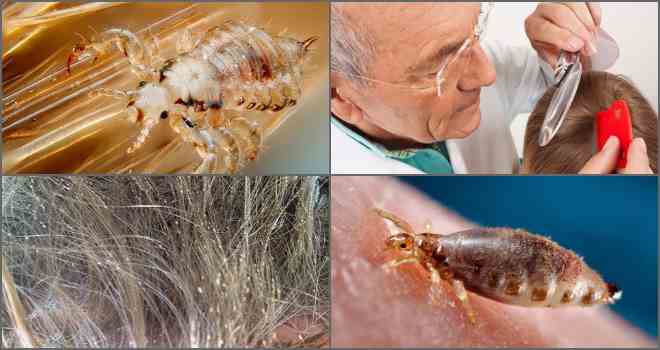
There are other signs of lice. On the scalp or on the body (if it is a linen parasite), you can see red spots, crusts and other phenomena that indicate that someone from the person is drinking blood, which is why the discomfort that is growing rapidly is growing.
Finally, pubic lice manifests itself in the same way, however, the main localization of insects is concentrated in the intimate zone. Even small wounds can develop there, since the skin in the groin is more delicate and sensitive than on the head.
How to cure pediculosis?
To the question of why lice start, why they can appear, the answer is found. But how to get rid of them? There are a huge number of effective and modern drugs with which the appearance of lice will not become a lingering problem.
A fairly effective remedy against parasites and nits in humans ─ Nittifor. It will help eliminate head and pubic insects. Using the tool is very simple. It is applied to the skin, such as the scalp.
There are also special shampoos against pediculosis that will help cure the emerging discomfort. They should wash their hair with a certain frequency (preferably every day) until pediculosis has passed.
Such shampoos also have a cleansing, moisturizing effect, so the use of conventional detergent is not required. Sifax, Itax, Antibit, Pedilin ─ these are not all the names of shampoos against pediculosis.
Knowing the answer to the question of why lice appear on the head, many people will be able to help both themselves and their child in case pediculosis becomes a real problem. Let a simple disease not be a cause for frustration, because it can be cured very simply and quickly.
Where do lice come from in a person's head initially: in children and adults
Everyone is at risk of pediculosis, and this does not depend on the person's cleanliness. Therefore, everyone should know how to get lice.
Meanwhile, despite the fact that we live in an age of global informatization, the people have a lot of speculation and belief in this regard. Even well-educated people sometimes express completely wild misconceptions regarding the appearance of parasites.
It is generally accepted that lice are the companions of poverty and an antisocial lifestyle, this, of course, is true, but no one is safe from this scourge.
How is pediculosis, head lice, pubic transmitted?
The answer to this question is clear - lice are transmitted from an infected person to a healthy person. Human lice do not parasitize animals, they cannot appear on their own, therefore only another person can become the cause of infection of one person. Lice are transmitted during friendly hugs or sexual intercourse.
The latter option is characteristic for the transmission of pubic lice. By the way, 3 species of these insects parasitize a person: head, linen and pubic lice. Underwear or clothes lice can be infected while wearing someone else's clothing. So you can "pick up" and head lice.
Causes of infection
Of course, no one will argue that the main share of the sources of pediculosis infection falls on the places where people leading an antisocial lifestyle gather. People at risk of contracting pubic parasites are those who do not keep order in their sex life.
Hygiene rules prohibit the use of personal items, which include combs, towels or hats.Lice can survive outside of humans for several days. In water, they can live 2 days.
Therefore, you can become infected with lice in the pond and in the pool, which was visited by a person infected with head lice. Both head and pubic lice can be in water bodies. If the latter fall on the child, they will parasitize on his eyebrows and eyelashes.
Sometimes children temporarily change their things with each other. Prohibit them from doing this, as it is quite possible to become infected in this way.
Pubic lice
Pubic pediculosis is usually transmitted through sexual intercourse, so it belongs to sexually transmitted diseases. Statistics report that lice infection is most common in winter. This is explained by the more frequent presence of people in the room.
As soon as a louse hits a person, it immediately begins to eat, and these insects, as you know, feed on human blood, there simply does not exist other food for them.
Already on the day of infection, the louse can lay its eggs, and since they lay them every day, the number of lice on the head can become critical very quickly. Lice live about 40 days.
It is noticed that lice appear especially often in children at the beginning of autumn. This can be explained only by the presence of children in summer camps, where, of course, great importance is attached to the rules of hygiene, but, again, ponds ...
False stereotypes of lice
Nervous Lice. Different versions of the appearance of lice in humans are widespread among the people, among which there are completely implausible. There is an opinion that lice may appear from nerves. This cannot be, because “from the nerves” - it means from nowhere, and this is already from the realm of fantasy.
I must say that this stereotype is very common, and such opinions can be heard not only from the village, but also from urban residents. But nothing can appear from nowhere, and lice are no exception.
Weakening the body. There is another misconception regarding the fact that lice are under human skin, and begin to show activity only when the body weakens. Perhaps the reason for this misconception was the fact of the existence of subcutaneous ticks.
These insects are in fact, and their presence causes severe itching, but they have absolutely nothing to do with lice. Nevertheless, opinions are sometimes expressed that the bulge of the skull is nothing more than subcutaneous accumulations of lice.
Lice leave their shelter when a person begins to get nervous, as his body temperature rises at this time. Such statements should not be taken seriously, of course.
But here I must say that the smell of sweat is really very attractive to lice. In a state of stress, people actually sweat, so the appearance of lice in a person can be associated with a stressful state, but still they do not appear by themselves.
In principle, attracted by the smell of sweat, lice can appear on a person, but this is possible only in conditions of very close contact with the infected. The “nervous” theory of the occurrence of pediculosis can also be explained by the fact that pediculosis is confused with one of the dermatological diseases, which may very well be formed on the nervous system.
In this case, the skin of a person constantly itches, which constantly makes him want to scratch, but this has nothing to do with insects.Therefore, do not make hasty conclusions if you feel itchy. In this case, it is better to consult a specialist.
Pick up from cats and dogs. From animals to become infected with pediculosis is also impossible. Of course, lice can parasitize cats and dogs, but these are completely different insects that will never live on a human body. There are chicken lice, which also have nothing to do with human lice.
Nits of parasites in themselves cannot be transmitted from an infected person to a healthy one, because nits are only insect eggs, deprived of the ability to move. Nits can get on another person only with a fallen hair or when combing.
When in public transport, you need to especially be wary of contracting lice that live in the folds of clothes, and crawl onto the human body only for nutrition. With close contact, a body louse may very well move from person to person.
Features of infection of children
The process of pediculosis infection by children from infection of an adult is no different, but children are much more susceptible to infection with this disease, and there are several reasons for this:
- Children often neglect the observance of hygiene rules, they are willing to use other children's clothing items.
- Children have no barriers to close communication; during games, they always communicate closely with other children.
- Children are more sociable than adults.
- Minors often make contact with children from dysfunctional families.
It turns out that children are much more likely to get pediculosis than adults. Statistics say that they become infected 5 times more often than adults. Therefore, if you detect signs of lice on yourself, you should immediately check the children. It is possible that they became the cause of your infection.

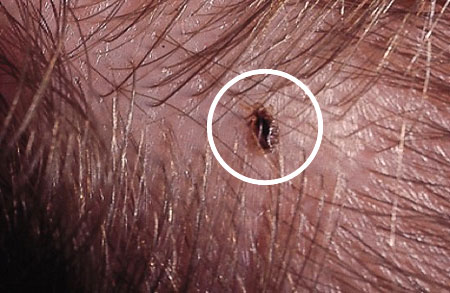
leave a comment